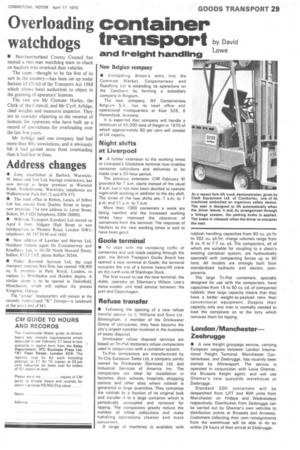Night shifts at Liverpool
Page 31

If you've noticed an error in this article please click here to report it so we can fix it.
• A further extension to the working times at Liverpool's Gladstone terminal now enables container collections and deliveries to be made over a 20-hour period.
The previous extension (CM February 6) provided for 7 a.m. starts instead of the usual 8 a.m. but it has now been decided to operate night-shift working in addition to the day shift. The times of the two shifts are: 7 a.m. to 7 p.m. and 11 p.m. to 7 a.m.
More than 1000 containers a week are being handled and the increased working times have improved the clearance of containers from the terminal. The response of hauliers to the new working times is said to have been good.
Goole terminal
• To cope with the increasing traffic of containers and unit loads passing through the port, the British Transport Docks Board has opened a new terminal at Goole; the terminal occupies the site of a former heavy-lift crane on the north side of Stanhope Dock.
The first vessel to use the new terminal, the Adda, operates on Eilerman's Wilson Line's twice-weekly unit load service between the port and Copenhagen.
Refuse transfer
• Following the opening of a new refuse transfer station by C. Williams and Sons Ltd, Birmingham, a member of the Drinkwater Group of companies, they have become the city's largest operator involved in the business of waste disposal.
Drinkwater refuse disposal services are based on Tri-Pak stationary refuse compactors used in conjunction with a container system.
Tri-Pak compactors are manufactured by Tr-City European Sales Ltd, a company jointly owned by Drinkwater (Services) Ltd, and Industrial Services of America Inc. The compactors are ideal for installation in factories, dock, schools, hospitals, shopping centres and other sites where rubbish is generated in large quantities. They compress . the rubbish to a fraction of its original bulk and transfer it to a large container which is periodically uncoupled and removed for tipping. The compactors greatly reduce the number of refuse collections and make hahdling operations cleaner and more convenient.
A range of machines is available with
rubbish handling capacities from 90 cu. yd /hr to 352 cu. yd/hr: charge volumes range from 9 cu. ft to 7.7 cu. yd. The compactors, all of which are suitable for coupling to a client's existing container system, are hydraulically operated' with compacting forces up to 50 tons, All models are strongly built from standardized hydraulic and electric components.
The large Tri-Pak containers, specially designed for use with the compactors, have capacities from 15 to 50 cu. yd. of compacted rubbish: their large capacity means that they have a better weight-to-payload ratio than conventional equipment, Despite their capacity only one man is normally needed to load the containers on to the lorry which removes them for tipping.












































































































